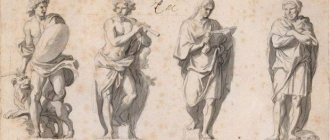The topic to which this article is devoted has been of concern to the global scientific community for several decades - it is directly related to the individual personal characteristics of people.
Everyone knows that the psyche of each person is unique. And this is connected both with the physical and biological characteristics of the organism, and with a complex of social characteristics. If we talk about biologically determined substructures, then, mainly, we need to consider temperament.
What is temperament?
Temperament implies the mental differences of people, which include the depth, intensity and stability of emotions, energy and pace of actions, emotional sensitivity and many other features of mental life. And the problem of temperament today remains controversial and unresolved. But even if we take into account all the diversity of approaches to its study, researchers agree that temperament is the biological foundation on which a person’s personality as a social being is based.
Temperament is a reflection of the dynamic aspects of behavior, which are mainly innate. Its properties are more stable than the properties of other mental characteristics of a person. And its most striking nuance is that the properties of the temperament of one particular person are not combined with each other by chance - they are interconnected naturally and form a certain conglomerate that characterizes the temperament.
To summarize: temperament must be considered as individually unique properties of the psyche that determine the dynamics of an individual’s mental activity; manifested equally in various activities, regardless of its motives, goals and content, and remaining unchanged already in adulthood, and also characterizing in the aggregate the type of temperament.
However, before considering the types of temperament and their features, it should be said that temperament cannot be bad or good, because Each type has its own advantages, and the efforts of any person should be aimed not at correcting its shortcomings, but at effectively applying its advantages in everyday life and activities.
A child and his temperament: test
Before starting testing, it is necessary to clearly understand that there are NO good and bad temperaments. Each of the psychotypes has its own strengths and weaknesses, especially since a “pure” temperament is an extreme rarity; in 90% of cases you will have to deal with mixed traits of different types, among which some dominate, while others are present.
Psychologists divide people by temperament into 4 groups. Each type has its own characteristics.
- Cholerics are explosive, emotional, instantly excited, and it is extremely difficult to calm them down. There is a risk of rapid exhaustion of the nervous system.
- Sanguine people are sociable, adapt well to changing conditions, are easy to communicate, and balanced.
- Melancholic people are whiny, vulnerable, kind and trusting, and often need increased tactile attention.
- Phlegmatic people are calm, sometimes too slow in terms of both physical and mental activity. Strong nervous system.
Do you recognize anything familiar? Surely you will find out. And now the test itself, which will help you orient yourself more clearly and understand what types of temperaments are dominant in your child.
Five questions with four possible answers, for each question you must choose a single answer.
Five questions with four possible answers, for each question you must choose a single answer.
How does the child react to comments and criticism?
a) Accepts it calmly, admits guilt, tries to correct it.
b) The main reaction is crying, resentment, concern.
c) Immediately asks for forgiveness, assures that it will NEVER happen like this again, and two hours or a day later he does the same.
d) Flies into a rage - stomps, screams, becomes aggressive, continues to do what he was doing.
What are we playing?
a) He is not afraid of playing alone; as a rule, these are quiet, concentrated activities without unnecessary emotions and body movements.
b) Prefers quiet games, but gets tired too quickly and begins to get distracted.
c) More often these are outdoor games; the child is inquisitive.
d) Likes to play for the “audience”; all entertainment is noisy and attracts attention.
Social position
a) When finding himself in an unusual environment, he remains calm, his emotions are extremely restrained, and his interest is not clearly expressed.
b) He gets embarrassed and hides.
c) It takes a minimum of time to adapt to a new place, is keenly interested in everything that deserves attention, and is included in a general conversation or business.
d) Behavior is overly excited, nervous, active.
How does a child make decisions?
a) Very balanced and calm, decision-making is not associated with the pangs of hesitation.
b) Takes time, acts indecisively, doubts.
c) The choice is made instantly.
d) Makes a decision quickly, but can also change it quickly.
How does he communicate with peers?
a) The conversation is measured, free, calm.
b) He listens more than he speaks, he always stays behind the company, he catches up, he is indecisive in his manner of speaking.
c) Communication is easy, clear, fast. Does not interrupt other children, listens - agrees or reasonably objects.
d) Always speaks louder than everyone else, gets irritated in conversations, hears only himself, does not pay attention to the opinions of others.
And now the answers:
- Most “a”s are phlegmatic kids.
- Most b's are melancholic.
- Most “v”s are sanguine.
- Most "g"s are choleric.
Creation of typologies of temperament
Since ancient times, people have strived to understand and identify the typical mental characteristics of different people and unite them into a small number of generalizing models. It was these models that were called temperament types; moreover, they were very practical, because through them it was possible to predict the behavior of a person with a certain type of temperament in a specific life situation.
It is officially believed that the doctrine of temperament in general was created by the ancient Greek physician Hippocrates, who argued that people are distinguished by four main “body juices” - blood, phlegm, yellow bile and black bile. Following the teachings of Hippocrates, the equally famous physician of antiquity, Claudius Galen, created the first typology of temperaments of its kind and outlined it in his treatise “De Temperamentum”. According to his ideas, the type of temperament depends on what type of “juice” predominates in the human body. It was Galen who identified four known types of temperament: melancholic (black bile predominates), choleric (yellow bile predominates), phlegmatic (phlegm predominates) and sanguine (blood predominates). The presented concept has been of great importance to scientists for many centuries.
Constitutional typologies of temperament
Subsequently, many typologies of temperament were put forward. But the greatest interest is caused by those among them where the properties of temperament, interpreted as innate or hereditary, are associated with individual characteristics in physique. Such typologies are called constitutional (typology by W. Sheldon, typology by E. Kretschmer and others). But, of course, such concepts have been criticized by psychologists. And their main drawback is that they underestimate, and often completely lose sight of, the influence of the environment and social conditions on the formation of a person’s psychological properties.
Boris Mikhailovich Teplov was born on October 21, 1896 in Tula in the family of an engineer. Full member of the Academy of Pedagogical Sciences of the RSFSR. In 1914, after graduating from high school, he entered the philosophy department of the historical and philological faculty of Moscow University, but in 1916, due to the First World War, he was drafted into the army and sent to ensign school. He took part in hostilities on the Western Front. After demobilization, he continued his studies at Moscow State University, graduating in 1921. Then he was again drafted into the Red Army and worked in a number of its institutions, where he studied the psychological issues of camouflage.Since 1933 - head of the laboratory and department of the Institute of Psychology at Moscow University (in subsequent years it became the Research Institute of General and Pedagogical Psychology of the APM); was deputy director of this institute. He has been studying the problem of abilities and giftedness since the 50s. his interests focused on studying the typological features of the properties of the nervous system. He created his own psychophysiological school that studied this problem. B. M. Teplov died on September 28, 1965.
A more consistent position was taken by B. M. Teplov (1959). He noted the danger of confusing two concepts - type of behavior and type as a complex of properties of the nervous system (more precisely, a complex of typological features of the manifestation of such). He emphasized that they cannot simply be “superimposed” on top of each other.
On the one hand, in typical patterns of behavior a certain complex of properties of the nervous system may manifest itself, on the other hand, the doctrine of types as complexes of properties is needed precisely in order to scientifically understand patterns of behavior (Teploe, 1956, p. 6).
It should be emphasized that when they talk about a type, they mean an integral characteristic that reflects a complex (combination) of several properties. However, a number of authors talk about “strong type of nervous system”, “weak type of nervous system”, “inert type”, etc., thus building a classification based on only one typological feature of the manifestation of any property of the nervous system. At the same time, it is proven that strength and weakness are not polar manifestations of the same property, but different properties. This interpretation of the concept “type” is incorrect and is caused by ignoring the physiological essence of the properties of the nervous system or identification with the psychological manifestations of these properties.
In the laboratory of B. M. Teplov, a certain methodology was developed for studying the properties of the nervous system, a clear presentation of which was given by V. D. Nebylitsyn (1966). One of the fundamental provisions of this methodology is the requirement to study the properties of the nervous system, and not the types of higher activity. According to the author, “the classification of types of higher nervous activity, created on the basis of the doctrine of properties as if in development of this doctrine, was in fact, as the experience of applying this classification in physiology and psychology showed, an obvious step back in comparison with the original and higher degree, a fruitful idea about the basic properties of the nervous system... Too often it came down to the distribution of the contingent of subjects into four “types” and only, at best, the identification of several more intermediate “types”. Under these conditions, the number “four” inevitably acquired some mystical connotation” (V.D. Nebylitsyn, 1966, p. 7-8).
Indeed, the focus on only four types of higher nervous activity (by the way, still exists in textbooks on physiology, psychology and pedagogy) began to slow down the development of differential psychophysiology. Such combinations of typological features were identified (strong, unbalanced with a predominance of inhibition over excitation; weak with a predominance of inhibition, etc.) that could not be attributed to any of the variations of Pavlov’s classification. The problem became even more complicated when in the laboratory of B. M. Teplov they began to postulate new properties of the nervous system: lability, dynamism, concentration. Therefore, B. M. Teplov believed that at this stage of studying the problem, identifying typological features of the manifestation of the properties of the nervous system has greater scientific meaning than defining “types.” He rightly believed that no scientifically based classification of the latter is possible until the issues related to the basis of such a classification - the properties of the nervous system - are studied in detail.
V.D. Nebylitsyn, relying on this idea, argued:
The central problem of the “teaching of types” is not yet the application of a ready-made typological scheme to the study of questions of an applied nature, but a preliminary detailed study of the nature and content of the basic properties of the nervous system, the determination of their structure and the nature of the relationships (their compatibility) and only as a result of all this - raising the question of possible combinations of properties of the nervous system, including “typical” combinations, and the classification of types of the nervous system, if such is possible at all (1966, p. 9).
Unfortunately, this task - to find “typical” combinations of typological features of the manifestation of the properties of the nervous system - in the laboratory of B. M. Teplov - V. D. Nebylitsyn remained unsolved.
V.D. Nebylitsyn (1976), and later his student V.M. Rusalov (1985), distinguish two substructures in temperament, like a number of their predecessors (Heymans and Wiersma, Kretschmer, etc.): general activity and emotionality. The first represents, according to V. M. Rusalov, a component of a more highly organized structure - intelligence, and the second - a component of character.
Vladimir Dmitrievich Nebylitsyn was born on July 21, 1930 in Troitsk, Chelyabinsk region. Doctor of Psychological Sciences, Professor, Corresponding Member of the Academy of Pedagogical Sciences of the USSR. Graduated in 1952 from the Department of Logic and Psychology, Faculty of Philology, Moscow State University. For two years he conducted methodological work at the Dagestan Institute for Advanced Training of Teachers. In 1954 he entered graduate school at the Institute of Psychology of the Academy of Pedagogical Sciences of the RSFSR, which he graduated in 1957, defending his Ph.D. thesis. A student of B. M. Teplov, after whose death (in 1965) he headed the psychophysiology laboratory of the Research Institute of General and Pedagogical Psychology of the Academy of Pedagogical Sciences of the USSR, combining this work with the activities of the institute’s deputy director for science. In 1965 he defended his doctoral dissertation. In 1967 he was elected a corresponding member of the Academy of Pedagogical Sciences of the USSR. Since 1972, he was deputy director of the Institute of Psychology of the USSR Academy of Sciences. Died in a plane crash on October 1, 1972.
According to the ideas of V. M. Rusalov, temperament is based not on the properties of any separate biological subsystem, but on the general constitution of the human body, which is considered by him as a set of private constitutions - that is, the set of physical and physiological properties of the individual, enshrined in his hereditary apparatus. (I note that his introduction of private biochemical, neurodynamic and other physiological constitutions is very controversial.) In the general constitution, in the author’s opinion, it is necessary to include genetic, biochemical, somatic, physiological, and neurophysiological characteristics of a person.
In connection with such a “set” of components that make up temperament, it becomes unclear why V. M. Rusalov calls this formation - temperament - psychological. What is psychological in this “composition” (even if we take into account two psychological components - activity and emotionality, which are by no means only, and most likely - not so much psychological as physiological)?
In human biology, anthropology, and medicine, the concept of constitution (from the Latin constitutes - established, stable) is widely used to denote a set of stable, congenital or acquired characteristics.
Historically, the term “constitution” has two sharply different meanings. The first is the constitution as a set of the most significant individual characteristics and properties enshrined in the hereditary apparatus and determining the specificity of the reactions of the whole organism to environmental influences. In this sense, the constitution is considered as the functional unity of all physical and physiological properties of human individuality.
The second, narrower meaning is constitution as a body type, habitus, somatotype, physical characteristics of a person. In this regard, to eliminate the existing confusion in the use of the term “human constitution,” it is advisable to use the term “general human constitution.” Then the body type (habitus, somatotype) will be a particular constitution (macromorphological system). In this case, the set of stable essential features of biochemical processes or the set of basic properties of the nervous system, etc. will be a particular constitution of the corresponding body systems: biochemical, neurodynamic, etc. (V. M. Rusalov, 1979, pp. 25, 26- 27).
The position of V. M. Rusalov is also original because, as the scientist believes, “temperament does not exist before activity or outside activity in the broad sense of the word. It is formed in the process of the activity itself, as a result of the generalization of its dynamic psychological characteristics due to those individually stable neurophysiological (or, more broadly, biological) components that are included in it” (1985, p. 29). Thus, temperament, according to V. M. Rusalov, means the same thing as for others - character (as a phenotype). Hence the understanding of temperament given by V. M. Rusalov:
Temperament should be considered as a set of such mental traits, signs and properties of a person that arose as a result of the generalization of dynamic, formal characteristics that act as a manifestation of mental activities under the influence of stable individual biological determinants.
The author, unlike V.S. Merlin, includes temperament in the structure of personal properties, which is also not entirely consistent with his idea of the biological components that form the structure of temperament. After all, the researcher himself criticizes B. G. Ananyev for including these individual properties in the personality structure, considering them components of temperament. Obviously, he identifies concepts such as “personality structure,” which may include temperament as a biological basis, and “personal properties,” i.e., properties acquired by an individual in the process of his socialization (a person’s attitude to the world, to society, to other people, yourself, etc.).
According to V. M. Rusalov, there are as many types of temperament as there are general types of constitution. (If we adhere to the author’s understanding of the essence of temperament as a product of activity, another question arises: why not then distinguish the number of types according to the number of types of activity?) The only trouble is that, as the researcher admits, we are still far from knowing exactly (I would said - even approximately!) the number of types of general constitution of the human body.
The position stated above, adopted in the school of B. M. Teplov, was not a declaration of a final refusal to consider “types”. But, postponing consideration of this issue for the indefinite future, in the laboratory of B. M. Teplov, in fact, they stopped studying the types of higher nervous activity according to I. P. Pavlov - both theoretically and methodically (conditioned reflex methods for studying the properties of the nervous system were replaced by methods associated with human reactions to various stimuli). True, in recent years attempts have been made to revive the study of temperament types, linking them with specifically human types according to I. P. Pavlov (according to the predominance of the first or second signal system), and both of them with the properties of the nervous system (V. V. Pechenkov, 1997).
The theory of I. P. Pavlov
The fact that the course of mental processes and the behavior of an individual depends on the work of the nervous system, which plays a dominant role in the body, has been known for a long time. But the theory of the connection between temperament types and certain general properties of nervous processes was first proposed by the Russian physiologist I. P. Pavlov. It was subsequently developed by his followers.
In the understanding of Academician Pavlov, the type of nervous system is innate and is least subject to any changes under the influence of upbringing or environment. The properties of the nervous system, according to his ideas, form the physiological basis for temperament, which is a mental manifestation of the general type of the nervous system. Pavlov's subsequent studies on animals made it possible to identify types of nervous systems, which he proposed to extend to humans as well.
Bibliography
1. Luria A.R. Lectures on general psychology / A.R. Luria. - SPb.: Peter. — 320 s.
2. Maklakov A.G. General psychology / A.G. Maklakov. - St. Petersburg: Peter, 2001. - 592 p.
3. General psychology: Educational and methodological manual / Ed. ed. M.V.Gamezo. - M.: Os-89, 2007. - 352 p.
4. Petrovsky A.V. General psychology / A.V. Petrovsky. - M.: Education, 1976. - 479 p.
5. Sorokun P.A. Fundamentals of psychology / P.A. Sorokun. - Pskov: PGPU, 2005 - 312 p.
6. Merlin V.S. Essay on the theory of temperament / V.S. Merlin. - M.: Education, 1964. - P.3-18.
7. Petrova O.O. developmental psychology: Lecture notes / O.O. Petrova, T.A. Umnova. - Rostov-on-Don: Phoenix - 2005. - 222 p.
Posted on
Examples of similar educational works
Development of musical and creative abilities of children of middle preschool age in...
... “problem of the century”, since its solution is connected with issues of the general development and upbringing of the child, with the formation of his personality. The ability to be creative is something that has always been defining...
Development of the psyche in phylogenesis. The emergence and development of consciousness (Semenova L.E. General ...
... the brain is the central nervous system. Simultaneously with the development of the nervous system and receptors, they improve... to sensitivity. Irritability is the property of a living organism to react to ... a person in society (children - Mowgli have no consciousness) ...
Personality development pre-scientific. period
...take care of raising children. Explaining development, Aristotle, in contrast ... by force, is capable of changing the physiological properties of this organism in ... a child, certain affects, adults form his nature, his body, the entire system ...
Development of everyday activities in preschool age (from birth to 7 years)
... establish the simplest cause-and-effect relationships. Let us recall the features of the development of everyday activities at an early age: everyday processes contribute to expanding the child’s sphere of independence; - the child develops cultural and hygienic skills,...
Development of physiology and internal medicine in the modern era
... systems, nervous activity in the works of AM Filomafitsky, E.O. Mukhina, I.M. Sechenova, I.P. Pavlova, N.E. Vvedensky. 5. Development... mechanisms of juice secretion and the importance of the digestive properties of saliva, gastric juice and pancreatic secretions...
Components of temperament types
Every person has their own type of nervous system. Its manifestations (these are the characteristics of temperament) are an important part of individual psychological differences. The manifestations of any one type of temperament are very diverse; they can be traced in the manner of behavior, and also manifest themselves in the nature of mental activity, actions, sphere of feelings, motives, cognitive activity, characteristics of a person’s speech, etc.
To compose a psychological characteristic of one of the generally accepted types of temperament, they usually resort to the following basic properties:
- Emotional excitability - the speed of occurrence of an emotional reaction and the force of influence necessary for its occurrence;
- Introversion/extroversion – features of the dependence of a person’s reaction and activity. If they depend on external stimuli, then the person is an extrovert, if they depend on internal ones, then he is an introvert;
- Rate of reactions - the speed with which mental reactions and processes occur, speed of mind, rate of speech, etc.;
- Rigidity and plasticity – a person’s ability to adapt to external influences;
- Reactivity - the degree of involuntary reactions to internal or external stimuli of the same intensity;
- Activity – the intensity of a person’s impact on the outside world and the ability to overcome obstacles on the way to achieving a goal;
- The ratio of reactivity and activity is the dependence of human activity on internal or external circumstances, as well as beliefs, intentions, goals;
- Sensitivity is the level of the lowest intensity of external influence necessary for the occurrence of a mental reaction.
In connection with these properties, the outstanding Polish psychologist and doctor of science Jan Streliau gives the most popular characteristics of temperament types.
Why is it important to know your child's temperament?
From birth, all people are very different, even if they are siblings. With the same methods of education practiced in the family, one baby grows up with joy, like the sun, delighting and surprising, while the other is constantly upset, cries, capricious, and tires. This contrast often causes anxiety and misunderstanding among parents. And here friends and relatives also “show their concern”: “Why is he so whiny?”, “Maybe something hurts him?”, “You’ve completely spoiled him!” Why are you raising a “mama’s boy/daughter?” and so on. Moms and dads of little “aggressors” are knocked off their feet, they always think that something is wrong with their baby, they storm the offices of neurologists, try various folk “sedative” measures and remedies, turn to healers and healers, try dozens of programs on calming and development...
All this is in vain and the child is healthy in 99% of cases, you just need to look for the key to it, which is hidden deep in the intricacies of psychology. Mother Nature awarded the baby at birth with certain personal characteristics, knowledge of his temperament will help you understand and make friends with them.
How often, as children grow older, the gap between them and their parents widens. Misunderstanding, fatigue from communication, disappointment - this is the minimum that awaits families if they do not make timely efforts to understand, accept and competently correct the innate characteristics of behavior and development of their children. Knowing the temperament of their child, parents will be able to completely avoid or minimize the risk of conflict situations in the family, become true friends to their children, and open up for them many roads and paths in life.
Temperament types
According to J. Strelyau, the four main types of temperament are characterized by the following features:
Melancholic
A melancholic person is a person with high sensitivity and low level of reactivity. High sensitivity often leads to the fact that even a minor reason can cause tears. A melancholic person is painfully sensitive and very touchy. He has inexpressive movements and facial expressions, a quiet voice, poor movements, and a low energy level. As a rule, he is timid, unpersistent, unsure of himself, quickly gives up when doing things, has little ability to work and gets tired easily. The attention of such a person is unstable, all mental processes are slowed down. Most melancholic people are introverts.
Choleric
A choleric person is not particularly sensitive, has high activity and reactivity, and reactivity dominates, which is why he is quick-tempered, impatient, unrestrained, unbridled. Facial expressions, gestures and speech are rich and reflect the mood. His aspirations are stable, his interests are unshakable. The choleric person is persistent and sometimes has difficulty switching attention. In the vast majority of cases, choleric people are extroverts.
Phlegmatic person
A phlegmatic person is characterized by high activity, which dominates over low reactivity. He is insensitive and little emotional. External stimuli have a very weak effect on it; able to remain calm in unexpected situations. Also, phlegmatic people have slow and inexpressive movements, the same speech, and poor facial expressions. He has difficulty switching his attention, rebuilds habits and skills very slowly, but he has energy and high performance. Most phlegmatic people are introverts.
Sanguine
A sanguine person is a person with high reactivity, which is on par with activity. It is characterized by lively facial expressions, a wealth of gestures, a quick response to external circumstances, and ease of switching attention. Very sensitive, active, can work for a long time without getting tired. Disciplined, resourceful, has good ability to concentrate and self-control. His interests, moods and hobbies can change quickly. Almost all sanguine people are extroverts.
Summary
As noted above, none of the temperament types are either bad or good. In addition, a person cannot belong to only one single type - he can only have a predominant one, and the rest will be complementary. But, be that as it may, from the perspective of psychological science, types of temperament are only one of the ways of psychological assessment of a personality. You should also be aware that descriptions of temperaments may differ from one specialist to another and include many factors.








